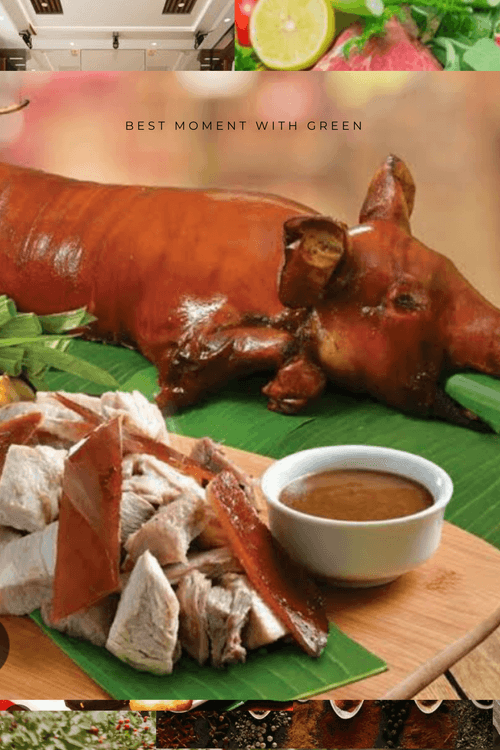A traditional and flavorful roasted suckling pig, commonly known as 'lechón,' often enjoyed in various cultures for special occasions.

Stuck mid-recipe?
Chefadora AI has the answer - timers, swaps, step-by-step help.
Ingredients
- suckling pig (about 15-20 lbs)1piece
- salt1/2cup
 black pepper1/4cup
black pepper1/4cup garlic powder1tbsp
garlic powder1tbsp onion powder1tbsp
onion powder1tbsp soy sauce2cups
soy sauce2cups vinegar (cane vinegar or apple cider vinegar)1/2cup
vinegar (cane vinegar or apple cider vinegar)1/2cup heads garlic, crushed (for stuffing)2
heads garlic, crushed (for stuffing)2 onion, quartered (for stuffing)1piece
onion, quartered (for stuffing)1piece bay leaves6piece
bay leaves6piece stalks lemongrass (optional for flavor)3
stalks lemongrass (optional for flavor)3
For the Basting Sauce
 melted butter1cup
melted butter1cup soy sauce1/2cup
soy sauce1/2cup vinegar1/2cup
vinegar1/2cup- brown sugar (optional for sweetness)2tbsp
Nutrition (per serving)
Calories
520.0kcal (26%)
Protein
30.0g (60%)
Carbs
10.0g (3.64%)
Sugars
2.5g (5%)
Healthy Fat
20.0g
Unhealthy Fat
10.0g
% Daily Value based on a 2000 calorie diet
How to make Suckling Pig (Lechón)
Prepare the Pig
- Step 1
Clean the suckling pig well, removing any remaining hair and insides. Rinse thoroughly and pat dry with paper towels.
Season the Pig
- Step 1
In a bowl, mix salt, pepper, garlic powder, and onion powder. Rub this mixture all over the pig, including the inside cavity.
- Step 2
In the cavity, place the crushed garlic, quartered onion, bay leaves, and lemongrass if using. This adds flavor to the meat.
Marinate
- Step 1
Combine the soy sauce and vinegar in a bowl. Pour some of this mixture into the cavity of the pig and spread the rest over the skin. Let it marinate for at least 4 hours, preferably overnight, in the refrigerator.
Preheat the Oven or Prepare Roasting Setup
- Step 1
If using an oven, preheat it to 300°F (150°C).
- Step 2
If roasting over an open fire or on a spit, prepare your fire for indirect heat.
Roasting
- Step 1
Place the pig on a roasting rack or in a large roasting pan. If roasting in the oven, cover it with foil for the first half of the cooking time to prevent the skin from burning.
- Step 2
Roast the pig for about 3-5 hours, depending on the size. The general rule is about 30 minutes per pound.
- Step 3
Baste the pig every 30 minutes with the melted butter, soy sauce, vinegar, and brown sugar mixture.
Crisp the Skin
- Step 1
For the last hour of roasting, increase the temperature to 375°F (190°C) to help crisp up the skin. Alternatively, if using a grill, you can move the pig closer to the heat source.
Check for Doneness
- Step 1
The pig is done when the internal temperature reaches at least 160°F (70°C), and the skin is golden brown and crispy.
Rest and Serve
- Step 1
Let the pig rest for about 20-30 minutes before carving. This allows the juices to redistribute.
- Step 2
Serve with a side of traditional dipping sauces, such as liver sauce or vinegar dipping sauce.
Nutrition (per serving)
Nutrition (per serving)
Calories
520.0kcal (26%)
Protein
30.0g (60%)
Carbs
10.0g (3.64%)
Sugars
2.5g (5%)
Healthy Fat
20.0g
Unhealthy Fat
10.0g
% Daily Value based on a 2000 calorie diet
Tips & Tricks
Ensure the pig is thoroughly cleaned to remove any remaining hair and insides.
Marinating overnight allows the flavors to penetrate the meat more deeply.
Cover the pig with foil during the initial roasting to prevent the skin from burning.
Basting regularly helps to keep the meat moist and flavorful.
FAQS
What is the best way to prepare and roast a suckling pig for a special occasion?
To prepare a suckling pig, start by cleaning it thoroughly and removing any hair. Rub a mixture of salt, pepper, garlic powder, and onion powder all over the pig, including the cavity. Stuff the cavity with crushed garlic, quartered onion, bay leaves, and optional lemongrass for added flavor. Marinate the pig in a soy sauce and vinegar mixture for at least 4 hours or overnight. Roast it at 300°F (150°C) for 3-5 hours, basting every 30 minutes, and increase the temperature to 375°F (190°C) for the last hour to crisp the skin.
Can I make a lechón recipe that is suitable for a gluten-free diet?
Yes, you can make a gluten-free version of lechón by substituting soy sauce with a gluten-free soy sauce or tamari. Ensure that all other ingredients, including vinegar and spices, are also gluten-free. This way, you can enjoy the traditional flavors of roasted suckling pig while accommodating gluten sensitivities.
What are some good substitutions for the ingredients in a suckling pig recipe?
If you don't have soy sauce, you can use coconut aminos as a soy sauce substitute. For vinegar, cane vinegar can be replaced with apple cider vinegar or white wine vinegar. If you prefer a different flavor profile, you can add herbs like rosemary or thyme instead of lemongrass. Additionally, you can skip the brown sugar if you want to reduce sweetness.
How should I store leftover suckling pig after roasting?
After roasting, let the suckling pig cool down to room temperature before storing. Wrap the leftovers tightly in aluminum foil or place them in an airtight container. Store in the refrigerator for up to 3-4 days. For longer storage, you can freeze the meat, which will keep well for up to 3 months. When reheating, ensure the internal temperature reaches at least 165°F (74°C).
What are some traditional side dishes or sauces to serve with lechón?
Lechón pairs wonderfully with traditional dipping sauces like liver sauce or a vinegar dipping sauce. You can also serve it alongside sides such as rice, plantains, or a fresh salad. For a festive touch, consider adding roasted vegetables or a tangy coleslaw to complement the rich flavors of the roasted pig.
Marnirni-apinthi Building, Lot Fourteen,
North Terrace, Adelaide, South Australia, 5000
Australia
